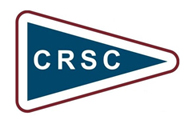CRSC Member Raymond Rose knows how to mix work with pleasure, especially when his job in A&E and Critical Care means he has to take an ambulance to one of the islands. Here is his second article, giving insight into an aspect of ferry-travel that few of us witness – fortunately!
Adventures To Arran (or The Misadventures of an Itinerant Ambulance Man to Arran)
Recap

Raymond Rose
Part one of this story was about my adventures getting to and from Islay as part of my job. In 2022 I retired from the Ambulance service (again) and moved to the Ayrshire coast, but I stayed on the retained list for the ambulance service and found myself covering some of the Islands and getting free ferry travel as a bonus. In the previous article I described my adventures on Islay, this time I’m relating my shifts on Arran, especially getting to and from it.
Probably most of the people reading this will be aware of where Arran is and know a good bit about the Island, but for those that don’t, I’ll do a quick summary. I should add at this point that aside from work, I’ve been travelling to Arran since I was in my early teens, so I’m very familiar with the island.
The island is off the coast of Ayrshire, about an hour’s sailing depending on which port you set off from (which is a controversial subject in itself). It’s roughly about 56 miles in circumference (I should know I’ve driven around it often enough) and is often described as Scotland in miniature (presumably because it’s got flat bits and hilly bits). It has a population of about 4500, which is added to considerably by visitors in the summer. The population is mostly concentrated on the east coast, split between Brodick (the main ferry port), Lamlash (the administrative centre) and Whiting Bay. The west side of the island is more remote, more difficult to get to and less populated, but it does have a smaller ferry terminal at Lochranza. In the summer this sails to Clanoaig and in winter to Tarbert (Loch Fyne).
Islay is bigger in land mass, but has a smaller population, at about 3750, which is more scattered into remote communities. Islay does, though, have an airport, in addition to a helipad, which means from a medical point of view, you can medivac people off by fixed-wing aircraft as well as helicopters. Cumbrae (or Millport as it’s more often referred to) is much smaller with about 1500 residents (again increased by summer visitors), has its own dedicated helipad and is of course much closer to the mainland than its bigger cousins.
The Trials and Tribulations of Brodick
Arran lacks a helipad. There used to be one at Brodick but with the redevelopment of the port it disappeared, and there has been about a decade-long argument about where to put a new one and who is going to fund it.
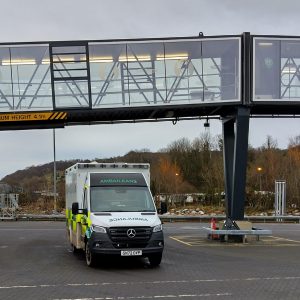
Ambulance under Brodick’s PAS
In practice there’s two places medivac helicopters can land which is dependent on the size of the helicopter and who it belongs to. If it’s the ambulance one, which are usually yellow, it’ll land at Sandbraes which is at Whiting Bay. It’s a football pitch and it’s not that unusual for the Coastguard to have to shoo people off the football field so the ‘copter can land. If it’s the coastguard one, which is red and white, it lands at the 4G pitches at Ormidale. Landing is influenced by helicopter size and CAA rules about what areas these ’copters can pass over before landing. Now why am I going on about helicopters when this is a tale about ferries? Because despite what a significant minority on Arran believe, ferries are still more reliable than helicopters in getting folk back over to the mainland, as they’ll sail in poorer weather and conditions than a helicopter, particular during the hours of darkness.
This brings us to Brodick, which is where we take anyone going off the island to a hospital, if they are having to go onto the ferry. Brodick used to be a simple wee port to navigate around in an ambulance but not so since it’s redevelopment into a quasi-super airport terminal. You’re never quite sure which way-in the port staff want you to go, either via the normal barrier entrance or against the one-way system, and then park-up under the PAS (that’s the Passenger Access System for the uninitiated, or boarding bridge: it used to be much easier when we just had a gangway!). This is further complicated by a number of factors:
-
- Which ferry we are boarding the passenger onto as the three within the remit of this article all have different requirements
- If the patient is boarding the ferry as a walking escorted patient
- When we get the call to take them to the ferry, as we cannot always be able to be there within the 30 minutes before the departure CalMac demand for the ordinary punters. This is due to the fact there’s only one ambulance on per shift and we may come off one job straight onto the transfer. It also depends on the availability of the ambulance crew on the mainland.
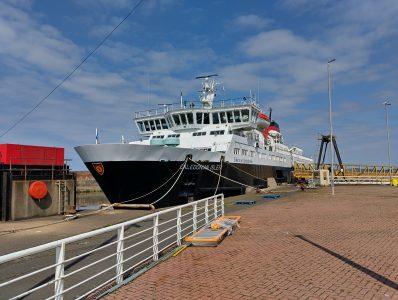
Caledonian Isles at Ardrossan
Let’s deal with the walking or escorted patient first. Walking is a bit of misnomer, as most of these patients won’t be able to walk very far and would have to be in a wheelchair to be taken up to the ferry. You’d think this would be simple, but no, not in the new improved Brodick. You have to park up at the drop-off point nearest the terminal. For some reason people become very territorial about that drop-off point and trying to get them to move does require a bit of negotiation. Then, even if you get into the drop-off point, you need to have at least six feet of clear space behind you to drop the ramp, if required. Inevitably you’ve only just parked up when someone drives right in behind you and then gets very upset when they are told you need extra space.
Once in the terminal you get the lift up to the boarding lounge and then usually are given priority to take the patient up to the boat before the other passengers. Here we face the roller coaster that is the PAS. It’s not easy to negotiate a wheelchair along it, with the numerous up and down sections and joints between the sections to go over. You have to be careful not to pitch the patient out of the chair getting over the jointed sections. Usually, the mainland crew will be waiting for you at the ferry entrance and we then take the patient to a curtained-off area for them to be seated. Normally the mainland crew for these patients won’t have brought their ambulance with them. It’ll be sitting at Ardrossan or more likely at the present time Troon, waiting for them to return. This holds firm for the Caley Isles and Isle of Arran but for Alfred that’s a whole lot more fun!
I guess Alfred is at what we might call the cheap and cheerful end of the ferry market. For a start it’s not a drive-through RO-RO which gives us an interesting viewing at times, but we will come on to that. Access to the passenger areas is not via the PAS but via the linkspan and then up some steep steps which would challenge an able-bodied person never mind someone who is unwell. I haven’t counted the number of steps and but I’m pretty sure it’s between 30 and 40. Ah, I hear you say, it’s got a lift. Well, yes, but for a long time it was out of order. We were frequently told an engineer from Vietnam was coming to fix it, but it seemed they were coming on a slow boat! There’s no other alternative then but to physically take the patient up the steps. Before you get to that stage you have to get on via the linkspan and car deck. The Alfred was never designed for the linkspans and there’s a bit of a gap between the boat ramp and the linkspan. The ingenious CalMac folk sort this by having a thick bit of hawser laid between the ramp and linkspan. Okay for a car to get over or for a fit person, but not so easy with a wheelchair. Once you’ve surmounted that problem you then face up to the steps. Here Pentland ferries have a handy device called a stair climber which the Alfred crew are expert in using, and we transfer the patient from the wheelchair into it and then they take them up the stairs. It works, but in inclement weather the patient is exposed and of course in full view of the terminal so it doesn’t do much for their dignity. There are a few patients who find the motion of the Alfred a bit difficult if they are already feeling a bit nauseous.
Ferries x 3
The main ferries that I’m used to when working on Arran are:
-
- Caledonian Isles
- Isle of Arran
- Alfred
I’ve occasionally been involved with other ferries on the route, when they are covering, such as Lord of the Isles or Hebridean Isles, but not to any great extent.
Each of the main ferries under discussion here has to be approached in different ways when dealing with an ambulance bound patient.
Caledonian Isles, being an ‘enclosed deck’ ferry, means you cannot keep the patient within the ambulance, and they have to be offloaded into the metal box called the medical room. The mainland ambulance does not travel over with the crew, and so they take their kit into the medical room which has a stretcher trolley in it for the patient to lie on. To do this you drive the Arran ambulance up to the medical room, which if berthed at Brodick is always at the far end. You then perform a rather nifty three point turn to get the ambulance facing out again, as the CalMac staff want you to offload as quickly as possible as they’ll have held any other vehicles whilst you get on with it. To do this not only does the car deck have to be empty, usually, but the mezzanine decks must be up otherwise an ambulance won’t fit under it. At all times you must obey the commands of the deck officer who usually knows the layout of the deck and manoeuvrability heights better that me. That’s all well and good if you arrive in enough time to get on first. If you don’t you need to deal with a full car deck and at least one mezzanine deck loaded, and you are trying to do a three-point turn in a very confined space to get off again. One deck officer in that situation clearly forgot about the clearance below the mezzanine deck and beckoned me forward realising just in time the lights on the front of the ambulance were about to adorn the mezzanine deck. He stopped me just in time!
In comparison Isle of Arran is much simpler. She has an open rear deck and, at the discretion of the Master, the patient can travel in the ambulance. The mainland ambulance will travel over and come off and meet us under the PAS where we transfer the patient. Not ideal but it does work. The mainland ambulance then returns onto the ‘Arran’ and off they sail to the mainland.
Alfred is much the same as the Isle of Arran except, as it’s not a drive-through RO-RO, a certain amount of jiggery pokery is required to turn the ambulance once on board. The ambulance cannot go up the sides on Alfred like a car, but needs to turn in the middle of the car deck. It’s not particularly difficult if you are used to driving that size of vehicle, and it is dependent on how many cars are already on board that you must avoid. I quite enjoy the challenge. Unfortunately, not all people driving this size of vehicle enjoy it quite so much, which leads me onto my favourite bugbear, people who hire large motorhomes and haven’t ever driven anything that size before. It’s an issue almost entirely to do with the older generation, since after 1997, you needed to sit an extra test to gain your C1, to drive vehicles up to 7.5 tonnes, a category a lot of motorhomes will fall into. Prior to 1997 the C1 came automatically with your licence. The problem is that a lot of older people might have that capability on their licence, but in practice have never driven anything bigger than a car up until they retire and decide to hire a motorhome. As Alfred isn’t drive-through these vehicles have to be turned, or occasionally reversed on. The panic that ensues is wonderful to watch as they struggle to turn the vehicle, having little spatial awareness of its size or even worse, try and reverse on (despite most modern MoHos having reversing cameras). In some ways it is entertaining, in other ways you just want to go up and offer to move it for them!
Darkness Transfers
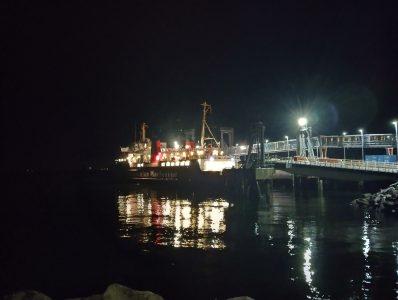
Isle of Arran at Brodick linkspan, Jan 2025
Darkness always adds a bit of spice and romanticism to the mix. As you come down the hill from Lamlash (where the hospital is) to the port at Brodick the ferry will be sitting there all lit up and it somehow reinforces the image of you being on a remote rock somewhere, rather than just an hour from the mainland. Darkness does make it a bit more complex, with your markers for reversing or manoeuvring being a little more difficult to spot, and adjusting from going onto brightly lit car decks and coming out into darkness, but very enjoyable still.
Ferry Number 4
It had been a fairly decent January weekend weather-wise on Arran and not too busy. A couple of calls on the Saturday and one transfer off on the morning ferry. Sunday morning, we were out assisting the coast guard and when we got back to the station the duty officer phoned me to say that the weather was due to close-in and they were taking me off on the 1430 ferry as my night shift relief was coming over on the same ferry as otherwise, they wouldn’t get over.
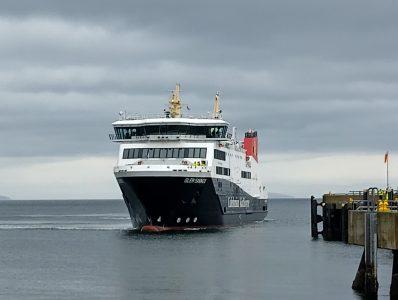
The brand new Glen Sannox approaching Brodick
Then it dawned on me (and virtually everyone else in the queue); this was a brand-new Glen Sannox, due to come into service on the Monday, doing an unexpected sailing on the Sunday. I was going to be rewarded with the first ever sailing from Brodick to Troon. I didn’t even care I was going back to Troon rather than Ardrossan, the excitement of seeing the new ferry put everything else out of my mind.
What a beautiful ship she is internally and whilst I’ve not used it yet, I’ve seen pictures of the medical room and it is well appointed and equipped. Maybe that’s one for the future, unless of course I retire completely….
Raymond Rose is a member of CRSC. Are you? If not, you’re missing out: we are a group of ship enthusiasts with an active programme of excursions, talks, publications, online presentations and much else. Sign up here and take advantage of all the benefits.
Published on 11 October 2025
